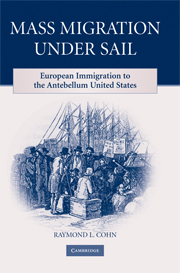Book contents
- Frontmatter
- Contents
- List of Tables and Figures
- Preface
- 1 A Unique Period for Immigration
- 2 The Onset and European Origins of Mass Immigration
- 3 The Jump in Immigrant Volume Around 1830
- 4 Push, Pull, and Other Factors in Antebellum Immigration
- 5 Who Were the Immigrants?
- 6 The Trip from Europe to the United States
- 7 The Immigrants in the United States
- 8 The Effects of Immigration on the United States
- 9 The End of Mass Migration Under Sail
- References
- Index
5 - Who Were the Immigrants?
Published online by Cambridge University Press: 30 June 2009
- Frontmatter
- Contents
- List of Tables and Figures
- Preface
- 1 A Unique Period for Immigration
- 2 The Onset and European Origins of Mass Immigration
- 3 The Jump in Immigrant Volume Around 1830
- 4 Push, Pull, and Other Factors in Antebellum Immigration
- 5 Who Were the Immigrants?
- 6 The Trip from Europe to the United States
- 7 The Immigrants in the United States
- 8 The Effects of Immigration on the United States
- 9 The End of Mass Migration Under Sail
- References
- Index
Summary
Although the number of people who left Europe for the United States increased over the antebellum years, who these individuals were has not yet been addressed. The popular view, summarized in the famous poem by Emma Lazarus, is that they were the “tired,” the “poor,” and the “huddled masses.” Although the poem was written in 1883, well after our time period, it summarizes the view of many toward the immigrants who arrived before the 1920s. This chapter uses data on the age, gender, and occupations of the immigrants to determine who the immigrants were relative to the European labor forces they left. For the period before the large increase in volume around 1830, the Lazarus view is clearly incorrect – all immigrant groups were positively selected, that is, they were more skilled than the underlying labor forces they left. When immigrant volume increased, the skill levels fell and the situation becomes somewhat less clear. Over the entire antebellum period, however, a comparison of the arriving Germans, British, and Irish finds that the average skill level went from highest to lowest in the order listed. The data on who the immigrants were also adds to the discussions in Chapters 3 and 4 concerning the reasons they left Europe.
Information on age and gender
Data on the gender and age of the total immigrant stream are available from the Passenger Lists for the 1820–60 period (Table 5.1). The male proportion always exceeded half.
- Type
- Chapter
- Information
- Mass Migration under SailEuropean Immigration to the Antebellum United States, pp. 98 - 124Publisher: Cambridge University PressPrint publication year: 2008



